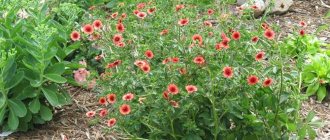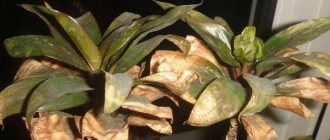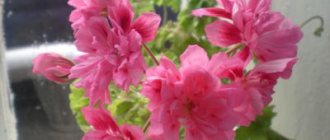Description of the plant and features
A compact, low (up to 1 meter in height) shrub, whose crown reaches about one and a half meters in diameter. Perennial, prone to abundant shoot formation , due to which the crown looks very voluminous.
Garden cinquefoil is valued for its long flowering period, which, with proper agricultural technology, begins at the end of May and lasts until the onset of cold weather. The flowers consist of five wide-open petals, whose velvety surface has been compared to expensive fabric.
In the center there are from 10 to 30 fluffy stamens, which gives the impression that the middle of the flower is covered with down. The color of the petals can be very diverse.
Gardeners value plants with white, pink, and yellow buds .
Potentilla received one of its names from the shape of the structure of the upper leaves. Young leaves have an elongated shape and are collected into a five-leaf clover.
Interesting! On the reverse side of the leaf blades, light silvery pubescence is clearly visible, which adds decorativeness to the bush.
Varieties, photos and descriptions
About 500 varieties of cinquefoil are known to scientists. These are the most popular in gardening.
| Name | Description |
| Yellow (goldfinger) | A low bush up to 0.8 meters in height, its diameter can reach up to 170 cm. From the beginning of summer, the crown of the plant is densely covered with large yellow flowers, which continue to open until frost. |
| Pink (Pink Queen) | A beautiful bush up to 1 meter in height and the same in diameter. The color of the buds is soft pink. The autumn change in color of the leaf blades from green to golden adds decorative value to the shrub. |
| Red (red ace) | Frost-resistant and tall bush - up to 170 cm in height. It has a relatively small crown size - about 1 m in diameter. An interesting feature of the plant is the change in color of the buds: in summer they are red-orange, and closer to autumn they acquire a distinct yellow note. |
| Daydown | It is distinguished by the compact size of the bush - about 0.7 m in height, while the diameter of the crown can be twice this figure. The flowering is long-lasting and very spectacular; from the beginning of summer the bush is densely dotted with rusty-red buds. |
| Hybrid | This variety was obtained by crossing several hybrids. It is distinguished by its slow growth rate, large yellow flowers and attractive silver-green color of leaf blades. |
| Large-flowered | It differs from other varieties in the large size of its open flowers - they can reach almost 5 cm in diameter. But the size of the bush is very modest, it does not exceed 30 cm. |
| Abbotswood | The bush grows about a meter in height, and the diameter of the crown slightly exceeds this value. The plant looks incredibly attractive during the flowering period, as it is densely strewn with snow-white corollas about 30 mm when opened. The variety tolerates short-term droughts well and can tolerate light partial shade, but still belongs to the light-loving varieties. |
| Merion red robin | A beautiful, slightly elongated bush up to half a meter high and up to 0.8 m wide. The color of the buds is red or red-orange. |
| Lovely pink | Doesn't stand out too much for its size. Much more attractive is the two-color color of the buds: deep pink at the edges and golden yellow in the center of the flower. |
| White (Potentilla Alba) | Grown as an ornamental shrub. From the end of spring until the beginning of autumn frosts, the bush is densely strewn with small white flowers. |
| Goose (Potentilla anserina) | It is a creeping herbaceous perennial, characterized by its ability to root long (up to 0.7 meters) shoots. |
| Cuff | The height of this wild-growing herbaceous perennial is about 30 cm. The plant received its name due to its small white flowers, shaped like falling cuffs. |
| Silver | Spreading perennial subshrub up to half a meter high. It is characterized by high frost resistance. The plant received its name for the silvery tint on the yellow-colored flower petals. |
| Sharp-toothed | The homeland of the plant is North America. The size of the bush is quite large and is about 0.75 meters in height. The color of the small flowers is very beautiful, creamy white. |
| Golden | A low-growing herbaceous perennial with a bush height of up to 0.25 m. Small golden-yellow flowers have a more intense color at the base of the petals. |
| Leafy | The plant is small and herbaceous. The color of small flowers is white and pink. |
| Kluza | Widely distributed in Europe. It is distinguished by its small size - the height of the herbaceous bush is no more than 15 cm. The flowers are small, up to 2.5 cm in diameter, painted white. |
| Alpine | The name is given according to the region of distribution - it is on the slopes of the Alps that you can find low bushes of this cinquefoil. The small flowers are rich yellow with a darker center. |
| Erect | An erect bush up to half a meter tall. Remarkable for the bright yellow color of the petals with a darker center. The flowers are small, their diameter does not exceed 1 cm. |
| Woolly | A low-growing creeping herbaceous plant, it has the ability to weave the soil, forming a dense carpet. It is notable for its abundant flowering and large size of golden-yellow flower cups - their diameter reaches 4 cm. |
| Shrub | A large erect shrub up to one and a half meters tall with delicate pale pink or white-pink corollas. |
| Nepalese | At a height of about 0.6 m, it produces rigid erect peduncles topped with red-crimson flower cups up to 2.5 cm in diameter. |
| Brilliant | It forms small clumps up to 20 cm in diameter, while the height of the bush is no more than 10 cm. It is notable for its variety of shades: the corollas can be of any color from soft pink to white. |
| Norwegian | The low bush, up to half a meter in height, is highly frost-resistant and easily tolerates frosts down to -40 °C. It has very small bright yellow flowers. |
| Bolotnaya | The height of the perennial herbaceous bush is about 45 cm. The diameter of the open flowers is about 3.5 cm. The petals are painted in reddish-brown tones. The plant is very frost-resistant. |
Red species
Potentilla varieties with red flowers are low hybrids:
- Marion Red Robin is a creeping plant. Red flowers in a muted brick hue appear in June and fade by September;
- Red Ace - a subshrub at the beginning of flowering, blooms bright scarlet flowers. In the sun they change their shade to copper;
- Gibson Scarlet - cinquefoil with blood-red shiny flowers, straight fleecy stems, 60 centimeters high;
- Miss Wilmott - belongs to the Nepalese varieties, is distinguished by lush flowering. The petals of the buds combine cherry and pink shades;
- Floris - petals of a coral shade acquire a fiery red color at the core.
An unusual variety of Nepalese cinquefoil is Roxana. The color of its buds is a mixture of coral, orange and red shades.
Red species of subshrubs will add a bright accent to a composition of white and yellow roses.
Planting in open ground
Cinquefoil is often used in the garden as a ground cover plant, which does not leave weeds a single chance to get through to the light. It is not difficult to grow, and care will not cause difficulties even for a novice gardener .
Landing dates
Cinquefoil seedlings are planted at any time from mid-spring to mid-autumn . The main requirement: the soil must warm up sufficiently so that the cinquefoil root does not get damaged.
Planting in autumn differs from spring planting only in the amount of water applied under the bush. Since moisture evaporates much more slowly in cool weather, freshly planted plants are watered with less water in the fall.
Choosing a landing site
When choosing a place for planting, you need to be guided by the amount of sunlight falling on the site .
Cinquefoil is a light-loving crop and you can expect abundant flowering from it only in good light. It is permissible to plant a bush in light partial shade, but you should not plant the plant in a shaded area - in this case, flowering may not occur at all.
Cinquefoil is generally tolerant of soil composition. The bush grows poorly only on heavy clay soils. Otherwise, it can be grown even on depleted soil .
Planting step by step
Before planting, the cinquefoil seedling needs to be soaked for a couple of hours in a solution of a drug that stimulates root formation . This will allow the cinquefoil to absorb moisture and speed up the plant’s adaptation to its new location. During this time, a pit is prepared for planting.
The hole dimensions are:
- 40 cm deep;
- 30 cm long;
- 30 cm wide.
A drainage layer must be placed at the bottom of the hole so that moisture does not come into contact with the roots for too long.
A layer of fertile soil is poured on top, the cinquefoil is planted and the hole is filled with fertile soil. The earth is compacted, the plantings are watered and only after that the soil around the seedling is mulched.
Care and cultivation
Caring for cinquefoil will not cause any difficulties, since the plant is unpretentious and hardy .
What goes with it?
You can plant cinquefoil next to other perennial ornamental plants - it goes well with any and does not conflict with them.
Potentilla looks great against the background of ornamental shrubs, shading them and becoming a transitional link from low-growing flowers to taller shrubs.
Read about colors that can be combined with cinquefoil:
Wonderful ranunculus or garden buttercup
Primula Akaulis: early and late varieties of spring primrose
Rudbeckia perennial - exotic chamomile in your garden
Watering and fertilizing
Water the cinquefoil very moderately and only during periods of prolonged drought; the bush also requires watering immediately after planting. The rest of the time, the bush has enough natural moisture that enters the soil along with precipitation .
Important! Potentilla can respond to an excess of minerals and nutrients by dropping buds that are ready to open and appearing sickly.
Fertilize the five-leaf plant three years after planting and do not apply more than 3 fertilizings in the spring . The rest of the time, no fertilizing is applied.
Features of care during the flowering period
Potentilla does not require specific care during the flowering period. It is enough to regularly remove faded buds to maintain the decorative appearance of the bush at the proper level.
Care after flowering
After the cinquefoil has bloomed, they begin to prepare it for winter . The shoots are shortened by 1/3 of the total length. The soil around is dug up and mulched with fresh humus. For prevention, the bush can be treated with Bordeaux mixture.
Wintering
It is necessary to organize wintering only for freshly planted seedlings and newly rooted cuttings . They are covered with spruce branches or straw.
Adult cinquefoils do not need shelter because they tolerate sub-zero temperatures well.
Pest Control
The most common pest of Kuril tea is the caterpillar. It damages the leaves of the bush and can lay eggs on the leaf blades. This leads to inhibition of development and deterioration of its condition. To combat insects, the drugs Actellik and Oberton are used.
Plants can also be damaged by a fungal disease - rust. For treatment, a solution of boron or manganese (5%) is used. As a preventive measure, it is recommended not to plant crops next to conifers, as they can infect the plant.
Trimming
Regular pruning helps give the cinquefoil crown the correct shape , prevent it from thickening and maintain abundant flowering.
Why trim
Potentilla shoots tend to become woody with age. They are too overloaded with weak, thin branches: this prevents the formation of new buds, and accordingly, the number of flowers decreases.
First trim
The first pruning is carried out immediately after planting . During this pruning, all damaged and weak branches are removed. Then reduce the length of the remaining shoots by a third. This stimulates the development of new flower buds.
Sanitary pruning
This pruning is carried out in the spring ; it consists of thinning the crown, removing damaged, dry shoots and branches with signs of disease development.
Stimulating
To stimulate abundant flowering, in the spring, cinquefoil shoots are shortened by a third of their total length .
Rejuvenating
Mature bushes with woody shoots need to be pruned regularly to allow new growth to grow. To do this, thick shoots are removed close to the ground or the crown is completely cut off at a level of 10 cm above the ground.
Reproduction of bush cinquefoil
The easiest way is to carry out vegetative propagation of the bushes you like. To do this, use the methods of cuttings or dividing the bush.
Propagation by cuttings
What begonia looks like - types and varieties of flowers
Green cuttings are cut at the beginning of summer and rooted in damp sand. For this, shoot segments 10-12 cm long are sufficient; they can be placed under a plastic bag to retain moisture. From time to time the bag needs to be removed for ventilation.
Dividing the bush
Potentilla can grow in one place for five or more years, so dividing the bush earlier than five years after planting is not advisable. The bush is dug up and divided into 2-3 parts, trying to leave a good rhizome for each part.
Note! When propagating by dividing the bush, 100% survival rate of new plants is ensured, and when cuttings it is about 60%.











